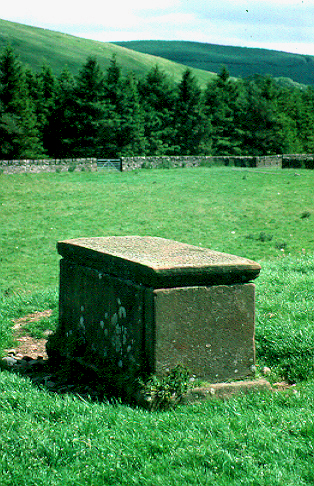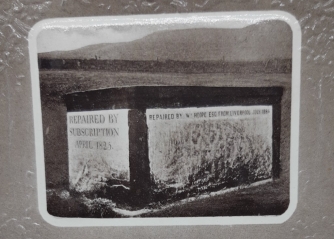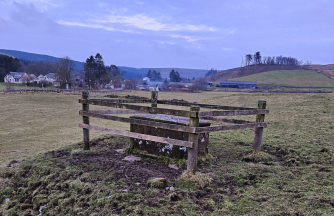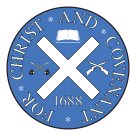Andrew Hislop's Grave
Andrew Hislop lived at home with his mother and siblings at Rennaldburn (NY 260968) or Windshiels (NY 161924) in Dryfesdale. They often sheltered Covenanters, one of whom died in their home. They buried him in secret. Word of this escaped, and Sir John Graham of Claverhouse and his men caught him in Dryfesdale. He was brought over the hills to Eskdalemuir. Sir James Johnstone of Westerhall (d. 1699) disinterred the body, destroyed the Hislop's home and stole their possessions. Andrew Hislop was sentenced to death at Eskdalemuir, carried out by Johnstone. He was shot on 12 May 1685 and buried at the spot. It is said to have been the last Covenanter death that Claverhouse was involved in.

Grave as it was for many years (above)
Andrew Hislop's Grave
Craighaugh
Eskdalemuir
Dumfriesshire
NGR - NY 249985
Hislop's grave comprises of a tablestone located in the middle of a small field off the B 709, just north of Craighaugh. It was erected in 1702 and Repaired by Subscription April 1825. It was also Repaired by Wm. Hoope Esq from Liverpool, July 1884. William appears to have lived at Dean Range, Padiham, near Burnley, in Lancashire, in 1887.
The inscription reads:
Here lyes and. Hislop
martyr shot dead upon
this place by Sir James
Johnston of Wsrhal
and John graham of C
laverhouse for adheri
ng to the Word of god
christs kingly govern
ment in his house and
y Covenanted work of
reformation ng tyran
ny pergury and prelacy
may 12 1685 re 12 11. Halt p
assenger one word wi
th thee or two why Iy
here wouldst thou tru
ly know by wicked han
ds hands Cruel & unj
ust Without all law
my life from me they
thrust & being dead
they left me on this s
pot & for burial this
same place I got. Tr
uths freinds in Es
kdale now triumph
their lot, wit, the faith
ful for my seal that
got. 1702.

Grave as it appeared on an old postcard (above)

Gravestone with wooden fence, 2024.
Andrew Hislop lived at home with his mother, younger brother and two sisters at a small house which stood near to Windshiels (NY 161924) in Dryfesdale, parish of Hutton and Corrie, Dumfriesshire. Their home, being remote, was often resorted to by wandering Covenanters. According to Rev Robert Wodrow, Hislop’s mother was a very honest, religious woman.
On one day one of the worn-out Covenanters arrived at their home seeking shelter. He was unwell, and after a few days died during the night. It was not known who he was. Frightened of what would happen to them if they made public this fact, Andrew and his family took the corpse out during the night and buried it in a neighbouring field, near to Bracheny Linns (NY 160934). The secret became known, and it was reported to the local laird, Sir James Johnstone of Westerhall (d. 1699) (NT 319893 – located near Bentpath, Eskdale). He was noted as being a zealous persecutor of the Covenanters. He came to Windshiels with his men and disinterred the coffin, broke it open and removed the corpse.
Working out, or perhaps having been told, who had been responsible for the burial, Johnstone then turned his attention to the Hislops. He ordered the destruction of the cottage and poinded all the Hislops’ possessions, calculated by the widow at £650 Scots. The family had to flee and find new lodgings.
Andrew Hislop went into hiding, but on one occasion when he was wandering in the fields he spotted John Graham of Claverhouse and his dragoons approaching. Hislop ran away, and tried to mount a horse that was nearby, however, the horse was unwilling to let him ride it, despite Hislop being known to it. Hislop then had to hide himself in a thicket nearby. He would have managed to evade capture as the soldiers passed by having missed him, but Hislop’s dog barked at their horses, giving his hideout away.
Hislop was captured and taken to Eskdalemuir, where he was sentenced. Claverhouse asked the locals for the use of a rope with which to bind him, but no one was willing to help. Indeed, one older woman took her own rope used for her cart and tied it around her own body to prevent it getting into Claverhouse’s hands. A local, described as being ‘without scruples’ handed over a rope and stated that ‘I’ll give you ropes to hang all the Whigs in Dryfe’. Hislop was then escorted across country to the home of Sir James Johnstone at Westerhall (NY 319892), four miles north-west of Langholm.
Sir James Johnstone had been a Covenanter at one time, but had changed sides and became a zealous persecutor. As Hislop had been arrested in the fields, the rules of the time allowed for him to be sentenced to death. Claverhouse was wary of carrying out the deed and requested that it be delayed for a time. Johnstone disagreed, and ordered that the execution take place. Claverhouse replied, ‘The blood of this poor man be upon you; I am free of it’.
Claverhouse ordered a highland captain who was with his dragoons to shoot Hislop, but he refused. The captain withdrew his men, saying, ‘Me no shoot that bony young man; me fight Clavers and a’ his men first’. Claverhouse then ordered three of his own soldiers to shoot simultaneously. Prior to the execution, Hislop was given time to pray and it is said that he sang some verses of the 118th psalm, ‘The mighty Lord is on my side’.
Once preparations were complete, the soldiers told Hislop to remove his bonnet and cover his eyes with it. He refused, telling the soldiers that he could face them without fear. He held up his Bible and told the soldiers that they would be judged one day by the book. The execution was carried out on 12 May 1685. Hislop was buried where he was executed, at Craighaugh, near Eskdalemuir.
It is said that Hislop’s mother was informed of her son’s capture and asked which one it was. When told that it was Andrew, she replied, ‘It is well, he is best prepared to die’. Tradition claims that she later gathered up his brains in a napkin.
Andrew Hislop's Grave was restored by the Scottish Covenanter Memorials Association in 2025. For more details click here.






